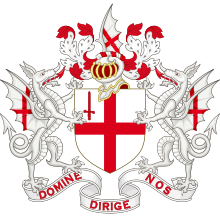Coat of arms of the City of London Corporation
| Coat of arms of the City of London Corporation | |
|---|---|
 | |
| Versions | |
 Stylised version, used as a logo by the City of London | |
Shield | Argent a cross gules, in the first quarter a sword in pale point upwards of the last |
| Supporters | On either side a dragon argent charged on the undersides of the wings with a cross throughout gules |
| Motto | Domine dirige nos (Lord guide us) |
The coat of arms of the City of London Corporation is the official coat of arms granted to the City of London Corporation. The Corporation governs the City of London, one of the 33 administrative areas within Greater London, England.
Description and blazon
The Corporation of the City of London has a full
The blazon of the arms is as follows:[1][2][3]
Arms: Argent a cross gules, in the first quarter a sword in pale point upwards of the last.
Crest: On a wreath argent and gules a dragon's sinister wing argent charged on the underside with a cross throughout gules.
Supporters: On either side a dragon argent charged on the undersides of the wings with a cross throughout gules.
The Latin motto of the City is Domine dirige nos, which translates as "Lord, direct (guide) us". It appears to have been adopted in the 17th century, as the earliest record of it is in 1633.[3][4]
A banner of the arms (the design on the shield) is flown as a flag of the City.
Historical development

The
The crest and supporters came into use in the 17th century, but were used without authority until 30 April 1957, when they were confirmed and granted by letters patent from the College of Arms.[1][2][3]
The crest is a dragon's wing bearing the cross of St George, borne upon a
On the seal of 1381 two lions were shown supporting the arms. However, by 1609 the present supporters, two silver dragons bearing red crosses upon their wings, had been adopted.[3][4] The dragons were probably suggested by the legend of Saint George and the Dragon.[2][6]
Gallery
-
Arms on seal of 1539
-
AtBlackfriars railway station
-
On Tower Bridge
-
On the walkway of Tower Bridge
-
City boundary marker: a single dragon supporter holds the shield of arms
-
Plain shield on a coal-tax post
-
On ashabraque, photographed at the Lord Mayor's Show, 2011
-
On a pub sign near Hammersmith Bridge
-
Lord Mayor Russell's personal arms during office (2019–2021)
-
Arms of the Port of London Authority
See also
Sources
- ^ ISBN 0-900455-21-7.
- ^ a b c d e f Beningfield, Thomas James (1964). London, 1900–1964: Armorial bearings and regalia of the London County Council, the Corporation of London and the Metropolitan Boroughs. Cheltenham and London: J Burrow & Co Ltd. pp. 21–23.
- ^ a b c d e f "The City Arms". Research Guide 11. London Metropolitan Archives. Retrieved 12 February 2018.
- ^ a b c d Fox-Davies, A. C. (1915). The Book of Public Arms (2nd ed.). London: T. C. & E. C. Jack. pp. 456–458.
- ^ Holinshed, Raphael (1577). The Laste Volume of the Chronicles of England, Scotlande, and Irelande, with their descriptions. London. p. 1033.
- ^ a b Scott-Giles, C Wilfrid (1953). Civic Heraldry of England and Wales, 2nd edition. London: J. M. Dent. pp. 245–246.
- ^ Crosley, Richard (1928). London's Coats of Arms and the Stories They Tell. London: Robert Scott. pp. 14–21.
External links
- "The City Arms". Research Guide 11. London Metropolitan Archives. Retrieved 12 February 2018.










